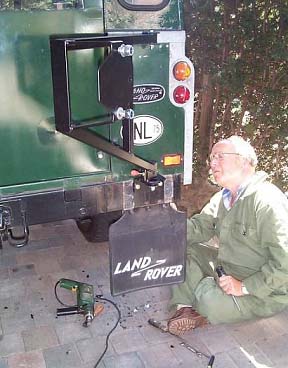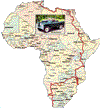After that we took her to Austria for the first time: a round trip of more than 2000 km. To our surprise Wa Bashasha ran without any noticeable problems. The engine didn’t overheat, brakes were working more or less, oil consumption stayed within limits and the engine and gearbox noise was deafening! There was an odd rattle whenever we worked the steering wheel through Austria’s hairpin curves, but she kept reasonably in her tracks. We had no reasons to complain. Back home, three weeks later, we undertook (and had undertaken) some more serious work.
- The old springs and shock absorbers were removed and new ones fitted. While on the job, we discovered that we hadn’t bought a normal 109” Series III but a 1-ton payload model, meaning heavy duty springs and extended heavy duty shock absorbers. Not really comfortable, but well suited for the African roads. Once under the car, we also located, with the help of our expert neighbour, the rattle. The three bolts securing the steering column to chassis had all come loose. We tightened them and checked on all the others bolts. The rattle was gone.
- As a precaution a new radiator and water pump were fitted and all hoses were exchanged for new ones. When
the radiator came out, we realised we had been lucky getting to Austria in the first place: all the cooling fins were corroded and only the main cooling channels were intact. The old water pump we took apart to fit new bearings.
It is now ready to go into the spare part box.
 From Paddock we obtained a spare wheel bracket for the rear body and mounting it was not much of a problem. Getting a sixth rim for a 1-ton model proved to be more difficult, but eventually we found a reasonably priced second hand one.
From Paddock we obtained a spare wheel bracket for the rear body and mounting it was not much of a problem. Getting a sixth rim for a 1-ton model proved to be more difficult, but eventually we found a reasonably priced second hand one.
- Being an ex-MOD, there were thick protected cables with mysterious electrical wires running everywhere. Afraid of becoming a victim of a system we didn’t understand, we decided to reorganise the wiring system. A Land-rover garage nearby mustered enough courage to pull out some 20 metres of wires and to remove all kind of gadgets we had no use for. To their and our surprise the car still ran!
- Next we removed the seat frames and the battery box and checked and cleaned the two fuel tanks. The seat frames were rusty and the adjustment lever of the driver seat was solidly jammed. A wire brush, lots of releasing oil and a fair amount of hammering did the job. After all components were degreased again, the lot was spray painted. The battery box looked bad, but after cleaning, de-rusting and spraying it too looked decent again. The top of the battery cover – in between the two seats – we used to fit a small aluminium case to hold the Toshiba Satellite laptop, its charger and a satellite phone. The lid of the case we covered with black carpet again. It looked less conspicuous and provided a comfortable additional armrest. On the front-side of the box two beaker holders were mounted. The fuel tanks looked horrible but after cleaning, which took us two days, they appeared to be in good shape. Inside and outside. Unfortunately both tank caps were damaged and without rubbers. We fitted two new ones.
Continued on next page...




 From Paddock we obtained a spare wheel bracket for the rear body and mounting it was not much of a problem. Getting a sixth rim for a 1-ton model proved to be more difficult, but eventually we found a reasonably priced second hand one.
From Paddock we obtained a spare wheel bracket for the rear body and mounting it was not much of a problem. Getting a sixth rim for a 1-ton model proved to be more difficult, but eventually we found a reasonably priced second hand one. 